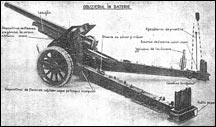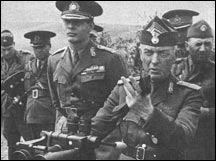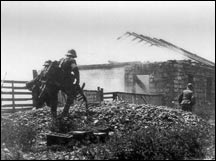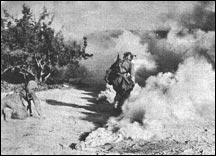| Armata Romana:
Kishinev,
1941
By Mike Bennighof, Ph.D.
May 2021
 The Soviet occupation of Bessarabia in 1940
guaranteed that if Romania saw a chance to
grab the province back, the Armata Romana would be on the move against the Red Army.
The government that returned the lost province
to the kingdom would instantly become extremely
popular, and most Romanian officers burned
to avenge their country’s humiliation.
The result was Romania’s participation
as part of the Axis in their June 1941 attack
on the Soviet Union known as Operation Barbarossa.
And their particular goal was the liberation
of Kishinev (Chisinau in Romanian). The Soviet occupation of Bessarabia in 1940
guaranteed that if Romania saw a chance to
grab the province back, the Armata Romana would be on the move against the Red Army.
The government that returned the lost province
to the kingdom would instantly become extremely
popular, and most Romanian officers burned
to avenge their country’s humiliation.
The result was Romania’s participation
as part of the Axis in their June 1941 attack
on the Soviet Union known as Operation Barbarossa.
And their particular goal was the liberation
of Kishinev (Chisinau in Romanian).
Romania’s commitment to Operation
Barbarossa included the recovery of Bessarabia,
but nothing more. Today making up most of
the independent Republic of Moldova, Bessarabia
had been taken by the Russians from Turkey
in 1812 and seized by the Romanians in 1919
during the chaos attending the Russian Revolution.
The elite Cavalry and Mountain Corps would
join the German 11th Army in clearing the
northern segment of the province, while the
V Corps forced a crossing at Falciu. The thrust
toward Kishinev, the province’s capital,
would be in the hands of Maj. Gen. Vasile
Atanasiu’s III Corps. V Corps had the Armata Romana’s best infantry divisions
(the Guard and 21st); 11th Army had the services
of the crack cavalry and mountain brigades
plus the lone Romanian armored division. III
Corps entered combat with only average units,
though enthusiasm for the so-called “Holy
War” against the Bolsheviks still had
currency in these early days of the war.

A Romanian Army handbook’s diagram
of the Skoda 150mm howitzer. Very few
of these modern guns were present at
Kishinev.
|
The actual battle opened in the late afternoon
of 2 July 1941, when the Romanian 35th Reserve
Division ferried two battalions of the 67th
Infantry Regiment over the river while Romania’s
Conducator, Gen. Ion Antonescu, along with
young King Michael, looked on. The operation
went well, with just one man killed in the
brief skirmish to scare off the NKVD border
guards protecting the crossing. Not much else
would come easily for the hapless 35th.
During the night, the 6th Danube Bridge Engineer
Company threw a pontoon span over the Prut
very quickly and efficiently (Romanian bridge
engineers would earn high marks throughout
the 1941 campaign). The rest of the 67th,
all of the 55th Infantry Regiment and the
division’s artillery crossed, and secured
a bridgehead. So far, things were going well.
Atanasiu sent his 15th Infantry Division across
the river on the 4th over its own bridges,
widening the bridgehead and awaiting the Soviet
response. It came the next day.
Atanasiu’s caution, reinforced by
the Romanian 4th Army’s commander, Nicolae
Ciuperca, came from Romanian intelligence
reports indicating that the Soviet 9th Army,
responsible for the southern segment of Bessarabia,
contained some of the Red Army’s best
formations. And so it did — the 74th
Rifle Division and both divisions of 2nd Cavalry
Corps were considered elite, and the 95th
Rifle Division was also very good. The Romanians
credited the Soviets with two tank brigades,
apparently unaware that these had been raised
to division strength during the previous spring.
Aided by a friendly civilian population, the
Romanian assessment was far more accurate
than that of the laughably incompetent German “Foreign
Armies East” department, and it gave
Atanasiu and Ciuperca pause. Neither general
could fathom why the Red Army did not strike
immediately.

King and Conducator watch the 67th Infantry
Regiment cross the Prut, 2 July 1941.
|
The answer lay in the general paralysis of
the Soviet command structure following the
German sneak attack. Shaken by the German
assault’s speed, Southwestern Front
requested permission to pull back to the Stalin
Line fortifications along the pre-1940 border.
Ninth Army, a separate command from Southwestern
Front, awaited the reaction of its northern
neighbor before committing its own troops.
After a delay of several days, the STAVKA
rejected the retreat option, ordering 9th
Army and 18th Army on its right flank to attack
at once and regain the Prut line.
In response, 95th Rifle and the cavalry corps
probed both flanks of 15th Infantry Division
on the morning of 5 July, and hit 35th Reserve
Division head-on. All of the Romanian units
held their positions. On the 6th, 11th Infantry
Division crossed the Prut and entered the
line south of 15th Infantry. Atanasiu ordered
all three divisions to advance on the next
day. Eleventh Infantry moved up the Cornesti
Heights against stiff opposition, 15th Infantry
against less. And 35th Reserve met nearly
fanatic resistance.
The reservists suffered disaster when a
Soviet tank-infantry task force routed 67th
Infantry Regiment and caught the division’s
63rd Artillery Regiment on the move. The gunners
tried to unlimber their outdated 75mm field
guns to fight the tanks at point-blank range,
with only mixed results. Wielding a light
machine gun slung over his arm, the divisional
artillery commander was wounded and both of
his battalion commanders killed leading the
defense. All of the 63rd’s guns were
lost, as well as two 155mm batteries of the
55th Motorized Heavy Artillery Battalion —
irreplaceable modern weapons in very short
supply in the Armata Romana. Shorn of most
of its artillery support, having lost over
2,200 prisoners in just a few hours’
fighting, Brig. Gen. Emil Procopiescu’s
division was crumbling rapidly.
With some bitterness, Antonescu formally
requested German assistance, and the German
72nd Infantry Division took over 35th Reserve’s
sector. Ciuperca ordered the corps over to
the defensive while reinforcements came up,
and two elite formations arrived over the
next two days – 7th Cavalry Brigade
and the Frontier Guard Division. Bloody fighting
continued on the heights, as the Soviets repeatedly
tried to throw the Romanians into the river.

Romanian soldiers on the attack.
|
On the 14th Atanasiu resumed the attack,
while on his left flank the German 54th Corps
committed its German 50th Infantry and Romanian
5th Infantry Divisions to an attack from the
northern flank. Despite heavy counter-attacks, the Romanian-German
offensive ground forward and the next day
Ciuperca brought the Romanian Royal Armored
Division into a breach opened by 54th Corps’
attack. The tankers penetrated deeply toward
the capital, finally being stopped by a counter-attack
by 47th Tank Division in a furious tank battle
along the Orhei-Kishinev Highway. Atanasiu
withdrew the remnants of 35th Reserve from
the front lines; it was broken up and its
remaining personnel used to replace losses
in other combat divisions.

Romanian soldiers on the attack. Again.
|
Romanian tanks entered Kishinev in the early
morning hours of the 16th, taking a number
of Soviet units there by surprise. By nightfall
the Red Army was retreating from the city,
heading toward the Dnestr River bridge at
Tighina on the border between Bessarabia and
Ukraine. The entire Bessarabian campaign cost
Romania 22,000 casualties, against 17,000
Soviets, but at the time most of the population
supported what they saw as the liberation
of national territory. But on 3 August 1941
Romanian cavalrymen forced a crossing of the
Dnester into the Soviet Union proper, as Antonescu
acceded to Adolf Hitler’s request for
active Romanian participation beyond the old
frontier. A new war, massive casualties and
national disaster awaited.
Click
here to order Armata Romana and send the Armata Romana into battle!
Sign up for our newsletter right here. Your info will never be sold or transferred; we'll just use it to update you on new games and new offers.
Mike Bennighof is president of Avalanche Press and holds a doctorate in history from Emory University. A Fulbright Scholar and NASA Journalist in Space finalist, he has published far too many books, games and articles on historical subjects.
He lives in Birmingham, Alabama with his wife, three children and his dog, Leopold. Leopold resists revision.
|
